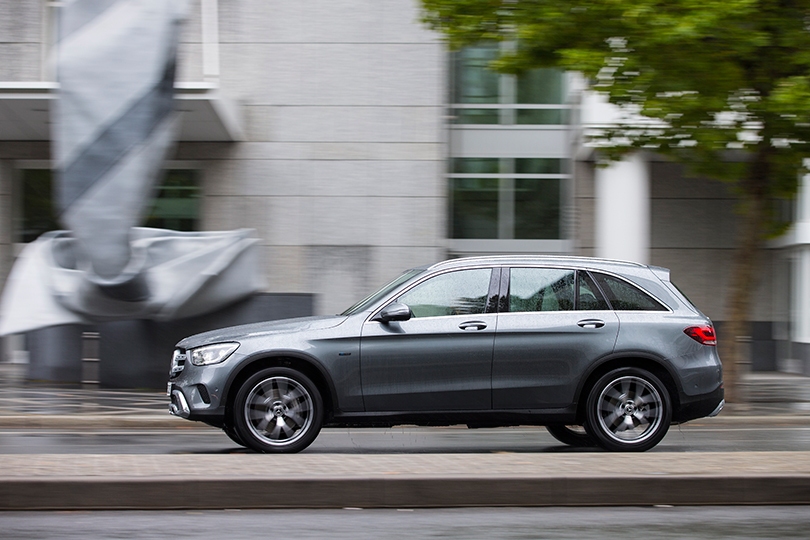European car makers are in a bit of a bind when it comes to methods of propulsion. Ever stricter emission rules mean that they have to make use of electric motors and batteries but many buyers aren’t quite ready for purely electric cars yet. The solution to bridging this gap comes in the form of Plug-in Hybrids. And Mercedes-Benz is doubling down on them with a raft of new models.
At the recent Frankfurt motor show, Mercedes introduced so many new and updated electrified models in fact that they had to be driven on and off the stage in turns of four at a time. On top of that, the brand announced that it will be fully carbon-neutral by the year 2039. A fairly bold claim, but they’ve given themselves twenty years to do it which seems altogether realistic. Still, getting there will be an uphill battle which starts now. All those 48-Volt mild hybrids are pretty clever but at the same time they aren’t making much of a dent in cars overall fuel consumption.
![]()
A much bigger step forward are plug-in-hybrid cars which use much larger batteries, more powerful electric motors and (as the name implies) they can be charged externally. Which means that you can pretty much consider them electric cars except for the fact that they also happen to still have a combustion engine for when long distances need to be traveled. There’s an obvious inefficiency about dragging two drivetrains around, but it seems that for now this may well be the most practical solution to reducing fuel consumption and the pollution that comes with it. I already got some time behind the wheel of the latest GLE 350de, GLC 300e and E 300e back when I was in Germany — and came away pretty impressed.
Let’s quickly go over the specs first. The 350de variant uses a 2 liter 4-cylinder turbocharged diesel engine which makes 194 horsepower on its own but is joined by a 136 horsepower electric motor which mathematically adds up to 320 total. The battery pack has a capacity of 31.2 kWh — pretty huge for a hybrid. All this adds up to about 100 kilometers of fully electric driving if you set off with a full battery. Meanwhile, the 300e drivetrain also combines an electric motor with a 2 liter 4-cylinder turbo engine but this one burns gasoline rather than diesel and total output is 315 horsepower. The battery pack in this case is a smaller but still respectable 13.5 kWh which translates to 40 kilometers or so worth of driving.
![]()
As the power numbers suggest, all these cars can move pretty swiftly if you want them to. The GLC 300e is the quickest of the bunch with a 0 to 100 kilometers per hour time of merely 5.7 seconds. For a sensible and environmentally friendly family oriented car that strikes me as incredibly fast. Not that the 6.8 seconds that the much bigger and heavier GLE 350de requires to reach that speed is any less impressive. It makes this large SUV powered by a small diesel engine and a bit of electricity faster than the first “fast” car I owned when I was I my early twenties. To me, that’s a mind boggling statistic.
One of the things that I always found fairly annoying about hybrid cars though was that if you wanted to take off from a red light at a reasonable pace the combustion engine would invariably kick in because the electric part on its own was only good for a little bit of power. For the same reason, you couldn’t really drive most hybrids at highway speeds fully electric either. Now, Mercedes-Benz has quite simply solved these issues and blown them into ancient history. Both the E 300e and GLC 300e will do at least 130 kilometers per hour only using the electric motor and the GLE 350d will reach a frankly staggering 160 km/h electrically. All of these cars will also accelerate from a dead stop more than quickly enough to leave most other traffic behind. It’s quite the revelation, actually. Especially when you consider the near total silence in which all this takes place.
![]()
Of course, if you really plant the accelerator pedal into the mushy carpet the regular engine will wake up to lend a hand. And when it does, the sound that you hear (distant and unobtrusive though it is) is not what you usually associate with the number “300” or “350” on the back of a Merc. Far though technology has obviously come, it has yet to discover a way to make a 4-cylinder engine sound pleasant. Fortunately, you can barely hear the combustion engine at the worst of times and when you make full use of the car’s hybrid systems it will be off most of the time anyway. That’s the plan with cars like these. They have big enough batteries to cover most commutes without emitting any harmful gases locally, and for long trips you’ve got the regular engine with a huge range that can be topped off in 5 minutes at a gas station.
![]()
Another reason why this works so well is that combustion engines are actually pretty efficient when you’re driving long distances at fairly constant speeds. They’re at their worst when navigating slow traffic through cities and such, and that’s where the electric part comes in to save the day. It of course also uses regenerative braking to recover energy that would usually be lost through braking and stores it in the battery instead. In the GLE 350d, you can choose how strongly you’d like the energy recovery systems to slow you down when you go off the throttle. I found myself using the highest level in the city and one step less on the highway, and you can switch between these settings easily with two paddles on the steering wheel. Shift paddles, basically, except in this car they aren’t wired into the gearbox but rather the hybrid powertrain.
![]()
It’s all pretty clever, and out on the road you often get a feeling that the computers that are watching you know pretty darn well what’s going on. For example, even when you’re not using the cruise control the car will use the sensors that detect how close you are to the car in front to change the level of energy recovery during coasting. What I mean by that is, if you let go of the throttle the car will decelerate quite slowly like any other car. But when it detects that you’re getting closer and closer to a car in front which would lead to you applying the brakes, it will instead ramp up the regenerative braking to increase the rate of deceleration so that you don’t even need to move your foot towards the brake pedal. It’s brilliant — and undoubtedly very efficient too.
![]()
I think what impressed me the most about Mercedes-Benz latest efforts in the realm of Hybrid vehicles is the rate of improvement from one generation to the next. These technologies are still very new and therefore improving at an incredible pace compared to what we’re used to with the “old tech” that is the combustion engine. With these new cars I feel that they’ve made plug-in-hybrid cars suitable for a much larger section of the population. The only catch which remains: you really do need to hook up the cars to a power plug as frequently as possible. You can easily charge the battery pack overnight in your garage or while you’re at work, in which case you’ll only very rarely have to visit a smelly fuel station ever again. Sign me up!











